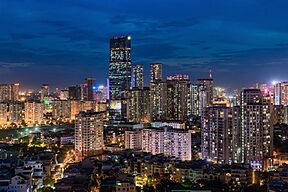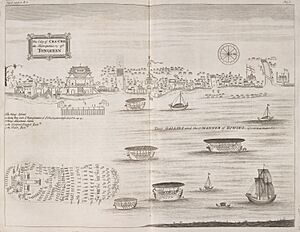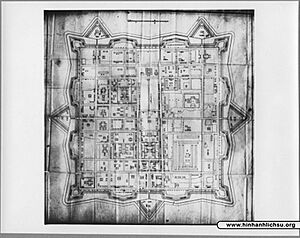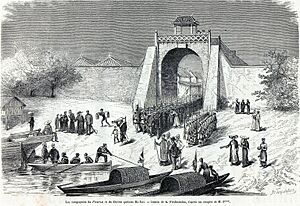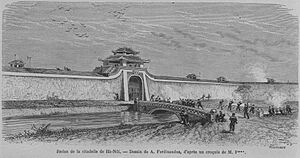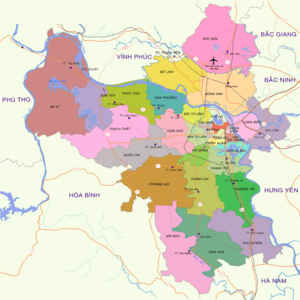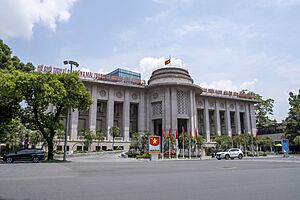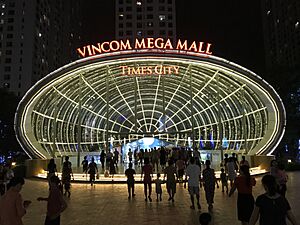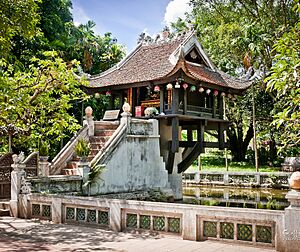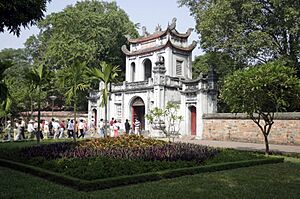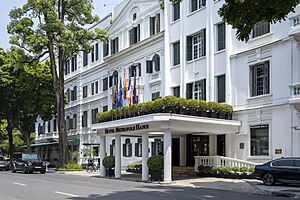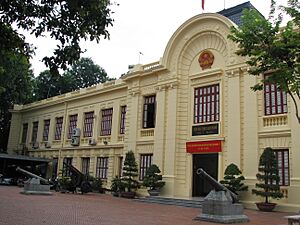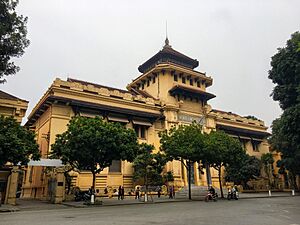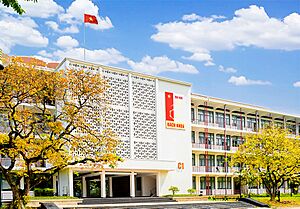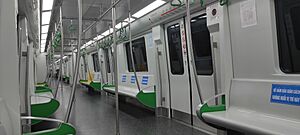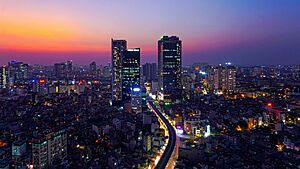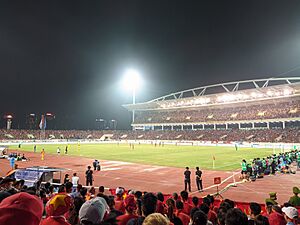Hanoi facts for kids
Quick facts for kids
Hanoi
Hà Nội
|
||
|---|---|---|
|
Capital municipality
|
||
| City of Hanoi Thành phố Hà Nội |
||
|
Hanoi's skyline
Turtle Tower
Hanoi Opera House
Imperial Citadel
St. Joseph's Cathedral
|
||
|
||
| Nicknames:
City of Soaring dragon
(Thành phố rồng bay) Thousand-year-long capital of civilisation (Thủ đô nghìn năm văn hiến) City for peace (Thành phố vì hoà bình) |
||
| Motto(s):
Dis lecta fortitudine prospera (historical)
|
||
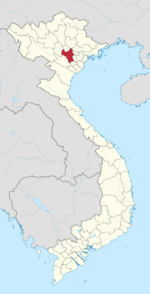 |
||
| Country | ||
| Region | Red River Delta | |
| Capital establishment | 1010 | |
| French occupation | 20 November 1873 | |
| Colonial liberation | 10 October 1954 | |
| Government center | Ba Đình district | |
| Subdivisions |
|
|
| Government | ||
| • Body | Hanoi People's Council | |
| Area | ||
| • Total | 3,359.84 km2 (1,297.24 sq mi) | |
| • Urban | 319.56 km2 (123.38 sq mi) | |
| • Metro | 24,314.7 km2 (9,388.0 sq mi) | |
| Highest elevation | 1,296 m (4,252 ft) | |
| Lowest elevation | 0 m (0 ft) | |
| Population
(2023)
|
||
| • Total | 8,587,100 | |
| • Rank | 2nd | |
| • Density | 2,555.806/km2 (6,619.51/sq mi) | |
| • Urban | 4,238,500 | |
| • Rural | 4,348,600 | |
| • Metro | 20,000,000 | |
| Demonym(s) | Hanoian | |
| Ethnic groups | ||
| • Vietnamese | 98.66% | |
| • Mường | 0.77% | |
| • Tày | 0.24% | |
| • Thái | 0.09% | |
| • Nùng | 0.08% | |
| • Others | 0.16% | |
| GRDP (Nominal) | ||
| • Municipality | US$ 51.4 billion (2022) | |
| • Metro | US$ 103.1 billion (2022) | |
| Time zone | UTC+07:00 (ICT) | |
| Postal code |
10xxx–14xxx
|
|
| Area codes | 24 | |
| ISO 3166 code | VN-HN | |
| License plate | 29 – 33, 40 | |
Hanoi (Vietnamese: Hà Nội) is the capital city of Vietnam and its second-largest city. Its name means "inside the river," because it is located between the Red River and Black River. Hanoi is made up of 12 city districts, 17 rural districts, and one town. The city covers an area of about 3,360 square kilometers (1,297 sq mi). In 2023, its population was over 8.5 million people. Hanoi's economy is very strong, ranking second in Vietnam for its economic output in 2022.
Hanoi has a long and interesting history. Around 300 BCE, the Cổ Loa Citadel was built here. For about a thousand years, the area was under Chinese rule. In 1010, a Vietnamese emperor named Lý Thái Tổ made it the capital of the country, calling it Thăng Long (meaning "ascending dragon"). Later, in 1428, King Lê Lợi changed the name to Đông Kinh ("eastern capital"). The name Hanoi was given to the city in 1831. From 1902 to 1945, it was the capital of French Indochina. After Vietnam gained independence, Hanoi became the capital of North Vietnam. In 2008, Hanoi grew much larger when nearby areas were added to it.
Today, Hanoi is a major center for culture, economy, and education in Northern Vietnam. As the capital, it hosts many foreign embassies and government offices. It is also a popular place for tourists, with millions of visitors each year. Famous landmarks include the Imperial Citadel of Thăng Long, Ho Chi Minh Mausoleum, Hoàn Kiếm Lake, and West Lake. The city's buildings show a mix of styles, from old French colonial designs to modern apartments.
Contents
- Exploring Hanoi's Many Names
- A Look Back at Hanoi's History
- Hanoi's Geography and Climate
- How Hanoi is Organized
- People and Cultures of Hanoi
- Hanoi's Economy and Growth
- City Planning and Development
- Famous Places to Visit in Hanoi
- Fun and Entertainment in Hanoi
- Delicious Food in Hanoi
- Learning and Education in Hanoi
- Getting Around Hanoi
- Sports in Hanoi
- Hanoi: A City for Peace
- Hanoi's Names in Nature and Space
- International Connections
- Images for kids
- See also
Exploring Hanoi's Many Names
Hanoi has been called by many different names throughout its long history. It was first known as Long Biên, which means "dragons interweaving." This name later inspired the famous Long Biên Bridge. Other old names like Tống Bình ("Song pacification") and Long Đỗ ("dragon belly") were also used. Many of Hanoi's older names include the word long (dragon). This is because the Red River curves around the city like a dragon.
In 866, the city became a fortress called Đại La ("big net"). This name is still used for major streets in modern Hanoi. When Emperor Lý Thái Tổ made it the capital in 1010, he named it Thăng Long ("ascending dragon"). This name is also used for a bridge and an expressway today. Sometimes, people refer to the city as Thăng Long – Hà Nội to remember its long history.
During different periods, it was also called Đông Đô ("eastern metropolis") and Đông Quan ("eastern gate"). Under the Lê dynasty, it was known as Đông Kinh, which gave its name to the region of Tonkin. In 1831, Emperor Minh Mạng officially renamed the city Hà Nội, which means "inside the river." This name has been used ever since.
A Look Back at Hanoi's History
Hanoi has been home to people for a very long time. Tools and signs of human life from 10,000 to 20,000 years ago have been found here. For a long time, much of the area was underwater. But for the last 4,000 years, people have lived here continuously.
Early Kingdoms and Chinese Rule
Around the 3rd century BCE, An Dương Vương built the capital of Âu Lạc in what is now Hanoi. This was the Cổ Loa Citadel, a large fortified city. In 179 BCE, the Âu Lạc Kingdom was taken over by Nanyue, starting a period of over a thousand years when China ruled Vietnam.
In 111 BCE, the Han dynasty of China conquered Nanyue. They divided the region into different areas, including Jiaozhi, which covered parts of modern Vietnam. In 40 AD, two sisters, Trưng Trắc and Trưng Nhị, led a rebellion against the Han rulers. The uprising spread quickly, but in 42 AD, a Chinese general named Ma Yuan defeated them.
By the 5th century, the Chinese Liu Song Dynasty built a fortified settlement in central Hanoi called Tống Bình (Songping). In 679, the Tang dynasty changed the region's name to Annan, with Songping as its capital.
In 866, a Chinese official named Gao Pian rebuilt the city and renamed it Daluocheng. He built strong walls around it. At that time, Đại La had about 25,000 residents, including traders from Persia, Arabia, and India. It became an important trading hub.
Independent Vietnam: Thăng Long and Beyond
In 1010, Lý Thái Tổ, the first ruler of the Lý dynasty, moved the capital of Đại Việt to the Đại La Citadel. He renamed it Thăng Long (meaning "ascending dragon"). This name is still used in poetry today. Thăng Long remained the capital until 1397.
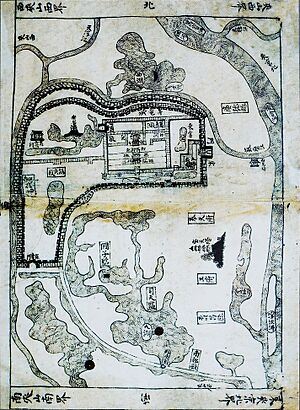
In 1408, the Chinese Ming dynasty took over Vietnam and renamed Đông Đô to Dongguan. But in 1428, Lê Lợi led a rebellion and ended Chinese rule. He founded the Lê dynasty and renamed the city Đông Kinh. By the 17th century, Đông Kinh had about 100,000 people.
French Colonial Period
When the Nguyễn dynasty began in 1802, the capital moved to Huế. Thăng Long was no longer the main capital. In 1831, Emperor Minh Mạng renamed it Hà Nội. The French military took over Hanoi in 1873 and again in 1883. Hanoi then became the capital of French Indochina in 1902.
World War II and the Vietnam War
Japanese forces occupied Hanoi in 1940 during World War II. After the war, in 1945, Ho Chi Minh declared Vietnam's independence, and Hanoi became the seat of the new government. However, the French returned in 1946. After nine years of fighting, Hanoi became the capital of North Vietnam in 1954.
During the Vietnam War, American bombing damaged Hanoi's bridges and railways. These were later repaired. After the war ended, North and South Vietnam were reunited on July 2, 1976, and Hanoi became the capital of the unified country.
Modern Hanoi's Growth
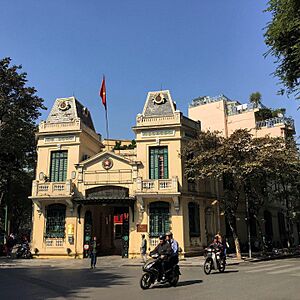
In 1978, Hanoi's borders were expanded, adding many surrounding districts. Some of these were later given back to other provinces, but in 2008, a large area, including Hà Tây Province, was merged into Hanoi again. This nearly tripled the city's size.
Since the 1980s, Hanoi has grown very quickly. New tall buildings have changed the city's skyline. However, the government has worked to protect the old parts of Hanoi, especially around Hoàn Kiếm Lake, by limiting high-rise buildings there.
Hanoi's Geography and Climate
Hanoi is located in the northern part of Vietnam, in the Red River Delta. It is about 90 kilometers (56 miles) from the coast. The city has three main types of land: delta areas, midland areas, and mountains. The land generally gets lower from north to south and from west to east. The highest point is at Ba Vi, which is 1281 meters (4,203 feet) high.
Weather in Hanoi
Hanoi has a humid subtropical climate with four distinct seasons.
- Summer (May to September) is hot and humid with lots of rain.
- Fall (October to November) is warm and mild.
- Winter (December to February) is cool and dry, with plenty of sunshine.
- Spring (March to April) often has drizzle and less sunshine.
Hanoi gets about 1,612 millimeters (63 inches) of rain each year, mostly from May to October. The average yearly temperature is 23.6°C (74.5°F). The coldest month averages 16.4°C (61.5°F), and the hottest month averages 29.2°C (84.6°F). Hanoi is the only capital city in Southeast Asia with a subtropical climate.
How Hanoi is Organized
Hanoi is divided into 12 urban districts, 1 town, and 17 rural districts. These are further divided into smaller areas like towns, communes, and wards. When Hà Tây merged with Hanoi in 2008, Hà Đông became an urban district, and Sơn Tây became a town.
| Administrative divisions of Hanoi | ||||||||||||||||||||||||||||||||||||||||||||||||||||||||||||||||||||||||||||||||||||||||||||||||||||||||||||||||||||||||||||||||||||||||||||||||||||||||||||||||||||||||||||||||||||||||||
|---|---|---|---|---|---|---|---|---|---|---|---|---|---|---|---|---|---|---|---|---|---|---|---|---|---|---|---|---|---|---|---|---|---|---|---|---|---|---|---|---|---|---|---|---|---|---|---|---|---|---|---|---|---|---|---|---|---|---|---|---|---|---|---|---|---|---|---|---|---|---|---|---|---|---|---|---|---|---|---|---|---|---|---|---|---|---|---|---|---|---|---|---|---|---|---|---|---|---|---|---|---|---|---|---|---|---|---|---|---|---|---|---|---|---|---|---|---|---|---|---|---|---|---|---|---|---|---|---|---|---|---|---|---|---|---|---|---|---|---|---|---|---|---|---|---|---|---|---|---|---|---|---|---|---|---|---|---|---|---|---|---|---|---|---|---|---|---|---|---|---|---|---|---|---|---|---|---|---|---|---|---|---|---|---|---|---|
|
||||||||||||||||||||||||||||||||||||||||||||||||||||||||||||||||||||||||||||||||||||||||||||||||||||||||||||||||||||||||||||||||||||||||||||||||||||||||||||||||||||||||||||||||||||||||||
|
|
||||||||||||||||||||||||||||||||||||||||||||||||||||||||||||||||||||||||||||||||||||||||||||||||||||||||||||||||||||||||||||||||||||||||||||||||||||||||||||||||||||||||||||||||||||||||||
HT – formerly an administrative subdivision unit of the defunct Hà Tây Province.
People and Cultures of Hanoi
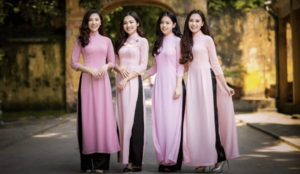
During the time when France ruled Vietnam, many French, Chinese, and Vietnamese people moved to Hanoi. In the 1940s, the city had about 132,000 people. After the First Indochina War, many French and Chinese people left.
Hanoi's population grew very fast in the second half of the 20th century. In 1954, it had 53,000 people. By 2019, Hanoi's population was over 8 million. It is the second most populated city in Vietnam, after Ho Chi Minh City. The city's population growth rate is higher than the national average.
Hanoi is a big city in Northern Vietnam and also the country's cultural and political heart. This puts pressure on its old buildings and roads. Many people who live in Hanoi today have moved there from other places. Even in the Old Quarter, where businesses have been for hundreds of years, many shops are now owned by people from other provinces.
Religions in Hanoi
The main religions in Hanoi for many years have been the three teachings (tam giáo). These include Buddhism, Taoism, and Confucianism. Most people in Hanoi consider themselves Buddhist, even if they don't practice regularly.
Ethnic Groups in Hanoi
Hanoi is home to over 50 different ethnic groups. The largest group is the Viet (Kinh) people, who make up about 98.66% of the population. Other groups include the Mường and Tày people.
Hanoi's Economy and Growth
Hanoi is one of the fastest-growing cities in the world in terms of its economy. In 2013, Hanoi contributed a lot to Vietnam's total economic output and attracted a significant amount of investment. The city's economy has boomed since the 1990s, especially in industrial production. Hanoi has many industrial parks, with more being built.
Trade is also a very strong part of Hanoi's economy. The city has thousands of businesses that trade with 161 countries. Tourism, finance, and banking are also becoming very important. Hanoi has a fast-growing real estate market, with many new urban areas and shopping centers.
Farming, which used to be a main part of Hanoi's economy, has also changed. Farmers are now using new plant types and modern farming methods.
Hanoi has seen many changes in its appearance due to economic growth. Roads and public transport are constantly being improved. Many international fast-food chains have opened in the city. The government also plans to replace traditional food markets with supermarkets.
Most jobs in Hanoi are in state-owned companies. However, private businesses are growing fast. Hanoi has rules about who can move into the city, preferring people with skills that help the economy. Many street vendors come from rural areas, showing that there are more chances to earn money in the city. The city government has tried to limit street vendors to modernize Hanoi's image.
Hanoi is also part of the Maritime Silk Road, a trade route that connects China to Europe by sea.
City Planning and Development
Hanoi has had several plans to guide its growth over the years. An early plan from 1924 was only partly built. Later, with help from Soviet planners, a new plan was made in the 1980s, but it didn't fit well with the city's existing layout.
More recently, two main plans have guided Hanoi's development. The Hanoi Master Plan 1990–2010 aimed to create new housing and business areas. A revised plan in 1998, to be completed by 2020, focused on managing the growing population. It aimed to limit tall buildings in the old city to protect its historic feel. A new rail transport system is also planned to improve public transport.
In the late 1980s, the United Nations Development Programme (UNDP) worked with Vietnam to improve rural infrastructure around Hanoi. This project focused on better roads, water, sanitation, and schools. It aimed to use local resources and involve communities to ensure long-term success.
Famous Places to Visit in Hanoi
Hanoi has been Vietnam's capital for nearly a thousand years. It is a major cultural center with many historic sites. Even after the capital moved to Huế in 1802, Hanoi continued to thrive. When the French took control, they added their own architectural style, which can still be seen today.
Hanoi's Old Quarter
The Old Quarter, near Hoàn Kiếm Lake, still has its original street layout and old buildings. In the early 1900s, this area had "36 streets," each specializing in a different trade like silk or jewelry. The street names still reflect these trades. The Old Quarter is known for traditional medicine, handicrafts, and local food. A night market opens here on weekends, selling clothes, souvenirs, and food.
The old houses in Hanoi show a mix of French and traditional Vietnamese styles. You might see French columns, Chinese writings, and Buddhist symbols on the same building.
Imperial and Historic Sites
Many imperial sites are in Ba Đình District. These include the Temple of Literature, which was Vietnam's first university, started in 1010. The One Pillar Pagoda was built in 1049 based on a king's dream. The Flag Tower of Hanoi is another important historic landmark. In 2004, a large part of the 900-year-old Hanoi Citadel was discovered.
Beautiful Lakes
Hanoi is often called the "city of lakes" because it has many scenic lakes. The most famous ones are Hoàn Kiếm Lake, West Lake, Trúc Bạch Lake, and Bảy Mẫu Lake. Hoàn Kiếm Lake is a historical and cultural center, linked to a legend about a magic sword. West Lake is the largest lake and a popular spot for relaxing, bicycling, and enjoying the views.
French Colonial Architecture
Hanoi was the capital of French Indochina for many years. Because of this, many buildings have a French colonial style. You can see tree-lined streets and many old villas and government buildings. Some famous examples include:
- The Presidential Palace
- The Grand Opera House
- St. Joseph's Cathedral
- The Long Biên Bridge
- The Hotel Metropole
- The Hỏa Lò Prison
Museums in Hanoi
Hanoi has many museums where you can learn about Vietnam's history and culture:
- National Museum of Vietnamese History
- Vietnam National Museum of Fine Arts
- Vietnam Museum of Ethnology
- Vietnam Museum of Revolution
- Hỏa Lò Prison
- Ho Chi Minh Museum
- Vietnam Military History Museum
- Hanoi Museum
Exploring Hanoi's Suburbs
Hanoi's western suburbs, which used to be Hà Tây Province, have important religious sites:
- The Thầy Pagoda in Quốc Oai District was built in the 11th century. It is one of Vietnam's oldest Buddhist temples.
- The Perfume Pagoda is a large group of Buddhist temples and shrines built into the mountains. It has a long pilgrimage route along the Yen river.
Fun and Entertainment in Hanoi
Hanoi offers many entertainment options. You can find modern and traditional theaters, cinemas, karaoke bars, and shopping places. The number of art galleries showing Vietnamese art has grown a lot recently.
A popular traditional show is water puppetry. You can see performances at the Thăng Long Water Puppet Theatre.
Delicious Food in Hanoi

Hanoi has a rich food culture. Many of Vietnam's most famous dishes started here, like bún chả, chả cá Lã Vọng, bánh cuốn, and cốm. Bún chả, a dish with grilled pork, noodles, and a sweet and salty soup, is very popular. Even former US President Barack Obama tried it during his visit in 2016!
Learning and Education in Hanoi
Hanoi was home to the first Western-style universities in Indochina. These included the Indochina Medical College (now Hanoi Medical University) and Indochina University (now Hanoi National University).
After 1954, many new universities were built, like the Hanoi University of Science and Technology. Many of Vietnam's major universities are in Hanoi. Students from all over the country come here for entrance exams in June and July.
Most schools in Hanoi are run by the government. Education is similar to the K–12 system in the U.S., with elementary, middle, and high school. There are also special schools for very talented students. People in Hanoi's city areas tend to have higher levels of education than those in the suburbs.
Getting Around Hanoi
Hanoi has many streets, bridges, and tunnels. The city is served by Noi Bai International Airport, which is about 15 kilometers (9 miles) north of Hanoi. A new highway and a cable-stay bridge connect the airport to the city center. Taxis are common and usually have meters.
Hanoi is also a major railway hub. The Reunification Express train runs from Hanoi to Ho Chi Minh City. Trains also go to other northern cities like Hai Phong.
The main ways people get around Hanoi are by motorbikes, buses, taxis, and a growing number of cars. Motorbikes are very popular. However, the increasing number of cars causes traffic jams. In 2017, the Hanoi government voted to ban motorbikes by 2030 to reduce pollution and traffic.
For quick trips, many people use "xe ôm" (motorbike taxis). You can also rent motorbikes in the Old Quarter.
Hanoi also has a new metro system. Line 2A opened in 2021, and Line 3 started operations in 2024.
Sports in Hanoi
Hanoi has several sports venues, including Mỹ Đình National Stadium, Quần Ngựa Sports Palace, and Hanoi Aquatics Sports Complex. These venues have hosted major events like the 2003 and 2021 SEA Games.
Hanoi also has two basketball teams, the Hanoi Buffaloes and Thang Long Warriors, that play in the Vietnam Basketball Association (VBA). There are also three professional football clubs in the city: Hanoi FC, Hanoi Police, and The Cong-Viettel.
Hanoi: A City for Peace
In 1999, UNESCO gave Hanoi the title "City for Peace." This was because Hanoi showed great efforts in promoting peace, helping communities, protecting the environment, and supporting culture and education. Hanoi is the only city in Asia-Pacific to receive this special title.
Hanoi's Names in Nature and Space
The name Hanoi has been used for many different living things, like insects and viruses. For example, there's a beetle called Adoretus hanoiensis and a virus called Tomato leaf curl Hanoi virus.
The name Hanoi was also given to an asteroid, 7816 Hanoi. This asteroid was discovered in 1987 and is almost 3 kilometers (1.9 miles) wide!
International Connections
Hanoi is part of international groups like the Asian Network of Major Cities 21 and the C40 Cities Climate Leadership Group.
Sister Cities Around the World
Hanoi has "sister city" relationships with many cities around the world. These connections help promote cultural exchange and cooperation.
Images for kids
See also
 In Spanish: Hanói para niños
In Spanish: Hanói para niños


